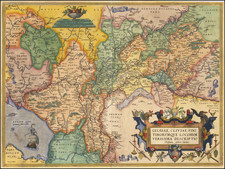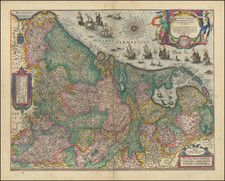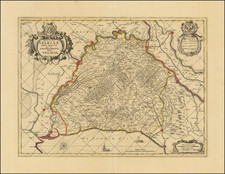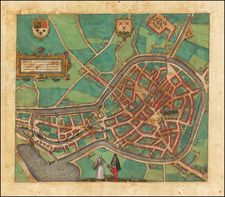Striking view of Maastricht.
From Braun & Hogenberg's Civitatus Orbis Terrarum, the most important book of town plans and views published in the 16th Century.
Translation of Title: Maastricht, a city that is well known because of its natural position, its fortifications, the size of its population, its buildings and great collegiate foundations, reveals itself as a double city joined by a magnificent bridge.
Translation of verso text:
Tricht is a large city, situated on both sides of the Meuse, joined by a fine stone bridge with ten arches. The part of the city that lies on the east bank is called Wyck. The city is subject in part to the bishop of Liège and in part to the Duke of Brabant, who is currently the invincible King of Spain, Philip. The main church is the Collegium of St Servatius, in which the relics of St Servatius and many other saints are kept.
The Traiectum ad Mosam - "crossing over the Meuse" - gave Maastricht its name, and the city is shown in a view from the east over the Wyck and the Meuse in bird's-eye perspective: on the right, above the 160-m-long stone bridge from the 13th century, we see first the Sint-Servaas basilica, on the left to the high tower of the late Gothic Sint-Janskerkand further to the left the late Romanesque Onze-Lieve-Vrouwe church from the 11th/12th centuries. From 1284 onwards Maastricht was under the rule of the Dukes of Brabant and the prince-bishops of Liège. A major historical event was the conquest and looting of Maastricht by the Spanish during the Dutch Revolt on 1579.
Georg Braun (1541-1622) was born and died in Cologne. His primary vocation was as Catholic cleric; he spent thirty-seven years as canon and dean at the church St. Maria ad Gradus, in Cologne. Braun was the chief editor of the Civitates orbis terrarum, the greatest book of town views ever published. His job entailed hiring artists, acquiring source material for the maps and views, and writing the text. In this role, he was assisted by Abraham Ortelius. Braun lived into his 80s, and he was the only member of the original team to witness the publication of the sixth volume in 1617.
Frans Hogenberg (ca. 1540-ca. 1590) was a Flemish and German engraver and mapmaker who also painted. He was born in Mechelen, south of Antwerp, the son of wood engraver and etcher Nicolas Hogenberg. Together with his father, brother (Remigius), uncle, and cousins, Frans was one member of a prominent artistic family in the Netherlands.
During the 1550s, Frans worked in Antwerp with the famous mapmaker Abraham Ortelius. There, he engraved the maps for Ortelius’ groundbreaking first atlas, published in Antwerp in 1570, along with Johannes van Deotecum and Ambrosius and Ferdinand Arsenius. It is suspected he engraved the title page as well. Later, Ortelius supported Hogenberg with information for a different project, the Civitates orbis terrarium (edited by Georg Braun, engraved by Hogenberg, published in six volumes, Cologne, 1572-1617). Hogenberg engraved the majority of the work’s 546 prospects and views.
It is possible that Frans spent some time in England while fleeing from religious persecution, but he was living and working in Cologne by 1580. That is the city where he died around 1590. In addition to his maps, he is known for his historical allegories and portraits. His brother, Remigius, also went on to some fame as an engraver, and he died around the same time as his brother.









![[ Leiden ] Leyda, Batavorum Lugdunum, vulgo Leyden . . . M D LXXIIII](https://storage.googleapis.com/raremaps/img/small/98268.jpg)



![Mechlinia [Mechelen]](https://storage.googleapis.com/raremaps/img/small/80595.jpg)
